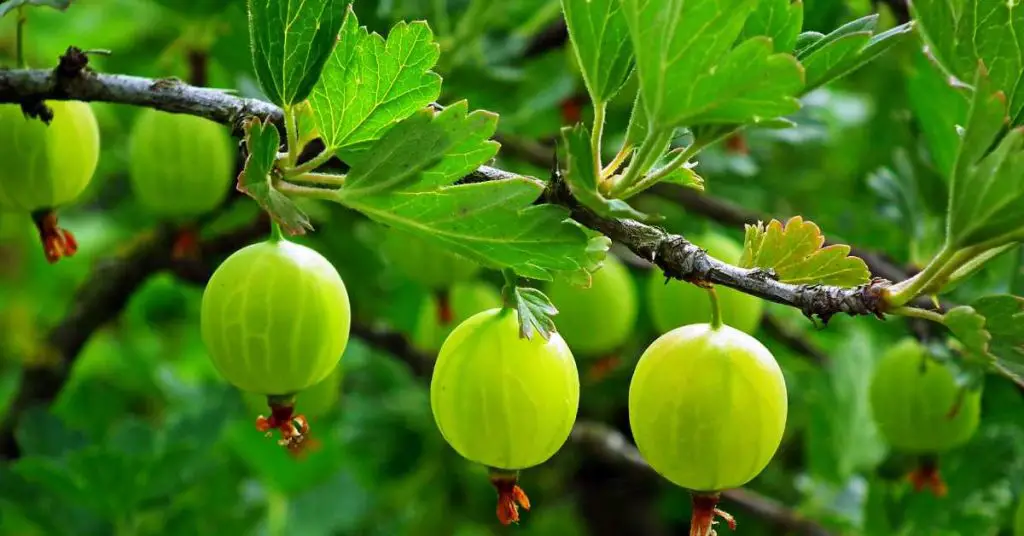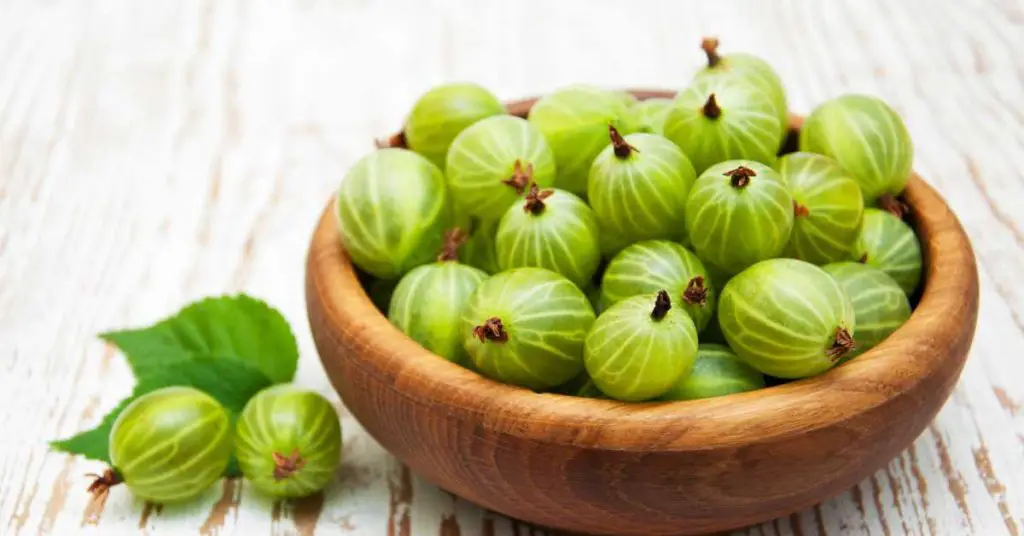Are you ready to embark on a journey of growing your own gooseberries from seed? Well, get ready to experience the joy of nurturing these delightful fruits right in your own backyard.
Contrary to popular belief, growing gooseberries from seed is not only possible but also a rewarding endeavor. In fact, with the right knowledge and techniques, you can successfully grow your own gooseberry plants and enjoy the fruits of your labor.
In this article, we will guide you through the process of growing gooseberry from seed, from understanding the different types of gooseberry seeds to providing the ideal conditions for germination and growth. You will learn how to choose the right soil and location for planting, as well as how to properly prepare and soak the seeds for optimal germination.
We will also discuss the importance of providing adequate water and sunlight for the plants, and how to harvest and enjoy the delicious gooseberries they produce.
So, if you’re ready to embark on this exciting gardening adventure, let’s dive into the world of growing gooseberry from seed and start cultivating your own thriving gooseberry plants.
Key Takeaways
- Soaking seeds in water for 24 hours enhances germination
- Gooseberries thrive in well-drained, slightly acidic soil with pH between 5.5 and 6.5
- Provide support for the plants as they grow
- Regularly inspect plants for pests and diseases
Understanding the Different Types of Gooseberry Seeds
So, you’re ready to dive into the world of growing gooseberries from seed, and understanding the different types of gooseberry seeds is the first step towards successful cultivation.
There are various varieties of gooseberry seeds available, each with its own unique characteristics. Some common varieties include the Hinnomaki, Invicta, and Pixwell. These seeds differ in terms of taste, size, and color, so it’s important to choose the variety that suits your preferences.
When it comes to germinating gooseberry seeds, there are a few tips for success. First, soak the seeds in water for 24 hours before planting to enhance their chances of sprouting. Secondly, plant the seeds in a well-draining soil mix, ensuring a depth of about 1 inch. Lastly, maintain a consistent moisture level and provide adequate sunlight for optimal growth.
By following these tips, you’ll be well on your way to successfully germinating gooseberry seeds.

Choosing the Right Soil and Location for Planting
First, imagine finding the perfect spot in your garden, where the soil is rich and the sunlight filters through the branches of nearby trees. Choosing the right soil and location for planting your gooseberry seeds is crucial for their growth and development.
Gooseberries thrive in well-drained soil that’s slightly acidic with a pH level between 5.5 and 6.5. Ensure that the soil is fertile and has organic matter incorporated into it to provide the necessary nutrients for the plants.
When it comes to sunlight, gooseberries prefer a location that receives at least six hours of direct sunlight each day. This allows them to photosynthesize and grow efficiently. Additionally, proper watering is essential for gooseberry growth. Water the plants deeply but infrequently to encourage deep root development.
By providing the right soil, location, sunlight, and watering regime, you can create the perfect environment for your gooseberry seeds to flourish.
Preparing and Soaking the Seeds for Germination
Now that you’ve found the perfect spot in your garden and have the right soil and sunlight, it’s time to prepare your gooseberry seeds for germination by giving them a good soak.
Soaking the seeds is an essential step to ensure successful germination. The best time for seed soaking is in the evening, allowing them to soak overnight. Start by filling a container with room temperature water, ensuring it’s deep enough to cover the seeds completely. Gently place the seeds into the water and let them soak for about 12 to 24 hours.
This soaking technique helps to soften the seed coat and promote faster germination. Remember to discard any seeds that float as they’re likely not viable.
After soaking, remove the seeds from the water and proceed with the next steps of germination.
Planting the Gooseberry Seeds in Containers or Beds
Once the seeds have been properly soaked, it’s time to transfer them into containers or beds for optimal growth. Container gardening and raised bed gardening are both effective methods for cultivating gooseberry seeds.
Here are some important points to consider when planting the seeds:
- Containers: Choose a container that is at least 12 inches deep to allow for proper root development. Fill the container with a well-draining potting mix, leaving about an inch of space at the top. Plant the seeds about half an inch deep and cover them with soil. Water the container thoroughly and place it in a sunny location.
- Raised beds: Prepare the raised bed by loosening the soil and removing any weeds or debris. Create a furrow about half an inch deep and place the seeds in the furrow, spacing them about two inches apart. Cover the seeds with soil and water the bed thoroughly.
- Maintenance: Keep the soil consistently moist but not waterlogged. Provide support for the plants as they grow and protect them from pests and diseases.
By following these guidelines, you can successfully grow gooseberry plants from seeds in containers or raised beds, providing a sense of belonging to your garden.
Providing Adequate Water and Sunlight for Growth
To ensure your gooseberry plants thrive, make sure to water them regularly and place them in a sunny spot. Proper watering techniques are essential for the growth and development of your gooseberry plants. Water your plants deeply, ensuring that the soil is consistently moist but not waterlogged. Avoid overwatering, as it can lead to root rot and other diseases.
During hot summer months, increase the frequency of watering to prevent dehydration. Gooseberry plants require at least six hours of direct sunlight daily to flourish. Choose a location that receives ample sunlight, preferably in the morning or late afternoon. If you’re planting in containers, ensure they can be easily moved to follow the sun’s path.
Providing adequate water and sunlight will promote healthy growth and ensure a bountiful harvest of delicious gooseberries.
Fertilizing and Mulching for Healthy Plants
Fertilizing and mulching play a crucial role in maintaining healthy gooseberry plants. The addition of organic matter through fertilizer application can provide essential nutrients and enhance soil fertility, resulting in increased fruit production. For instance, a gardener in California witnessed remarkable improvements in both the size and quality of their gooseberries by regularly applying a balanced organic fertilizer. This practice not only supplied the necessary nutrients but also promoted overall plant health.
In addition to fertilizer application, organic mulching is equally important. Mulching with compost helps retain moisture, suppresses weed growth, and improves soil structure. This method provides a protective layer around the plants, preventing soil erosion and maintaining a stable temperature.
Ultimately, fertilizing and mulching are essential techniques that contribute to the thriving growth of gooseberry plants, ensuring bountiful harvests for enthusiastic gardeners.
Pruning and Training the Gooseberry Plants
When you prune and train your gooseberry plants, you can shape them into beautiful, productive bushes that are easier to maintain. Pruning techniques play a crucial role in ensuring the health and productivity of your plants.
Start by removing any dead, damaged, or diseased branches, as well as any crossing or rubbing branches. This will improve air circulation and reduce the risk of disease. Additionally, pruning can stimulate new growth and increase fruit production.
To train your gooseberry plants, use a method called espalier, which involves training the branches to grow horizontally along a support structure. This not only maximizes space but also allows for easier harvesting and maintenance. Another training method is called fan training, where the branches are arranged in a fan shape against a wall or fence.
By employing these pruning techniques and training methods, you can ensure that your gooseberry plants thrive and provide an abundance of delicious fruit.

Protecting the Seedlings from Pests and Diseases
Protecting the little seedlings from pesky pests and diseases ensures their healthy growth and promises a bountiful harvest. When it comes to preventing pest infestations, using organic pest control methods is the way to go.
Start by regularly inspecting your gooseberry plants for any signs of pests or diseases. Look out for aphids, caterpillars, and fungal infections such as powdery mildew. To discourage pests, you can employ companion planting by growing plants like marigolds or garlic nearby, as their strong scent helps repel insects.
Additionally, consider using natural remedies such as neem oil or insecticidal soap to control pests. These organic options are effective in keeping pests at bay while minimizing harm to the environment.
By implementing these preventive measures, you can safeguard your gooseberry seedlings and promote their healthy development.
Recognizing and Addressing Common Growth Issues
To truly nurture your gooseberry plant, you must become its vigilant guardian, always attuned to the subtle signs of growth issues that may arise. Addressing growth issues and troubleshooting problems is essential for the successful cultivation of gooseberries from seed.
One common growth issue is stunted or slow growth. This can be caused by inadequate sunlight, poor soil quality, or improper watering. Ensure that your gooseberry plant receives at least 6-8 hours of direct sunlight per day and that the soil is well-draining and rich in organic matter. Additionally, water your plant regularly, keeping the soil consistently moist but not waterlogged.
Another growth issue to watch out for is yellowing leaves or leaf drop. This can be a sign of nutrient deficiencies, such as a lack of nitrogen or iron. Consider using a balanced fertilizer or adding compost to provide the necessary nutrients.
By recognizing and addressing these common growth issues, you can help your gooseberry plant thrive and ensure a bountiful harvest.
Harvesting and Enjoying the Fruits of Your Labor
Now that you’ve successfully recognized and addressed common growth issues with your gooseberry plants, it’s time to reap the rewards of your hard work and enjoy the delicious fruits they produce.
Harvesting gooseberries is an exciting and satisfying task. When the berries are ripe, they’ll have a firm texture and a vibrant color.
To preserve your gooseberries, consider freezing them or making jams and jellies. These methods will allow you to enjoy the unique flavor of gooseberries throughout the year.
Additionally, you can explore a variety of delicious gooseberry recipes. From pies and tarts to sauces and smoothies, the possibilities are endless.
Get creative in the kitchen and share your gooseberry creations with friends and family, creating a sense of belonging and delighting their taste buds.
- Freezing gooseberries
- Making jams and jellies
- Exploring delicious gooseberry recipes.
Saving Seeds for Future Planting
Ready to ensure a bountiful future harvest? Consider saving the seeds from your thriving gooseberry plants for future planting. Saving seeds is a simple yet essential step in preserving the genetic diversity of your plants and ensuring a continuous supply of gooseberries for years to come.
To begin, select fully ripened berries from healthy plants, avoiding any damaged or diseased fruits. Remove the seeds by gently crushing the berries and separating them from the pulp. Rinse the seeds thoroughly to remove any remaining fruit residue.
Next, spread the seeds on a paper towel or tray and allow them to air dry for a week or two. Once completely dry, store the seeds in a cool, dry place in a sealed container.
When the time is right, you can plant your saved seeds and watch your gooseberry garden flourish once again. Happy future planting!
Propagating Gooseberries through Cuttings
One fascinating fact about propagating gooseberries through cuttings is that they have a high success rate, with around 80% of cuttings developing into healthy plants. This makes it a reliable method for growing new gooseberry plants.
To propagate gooseberries through layering, follow these steps:
- Select a healthy, mature gooseberry plant with flexible branches.
- Choose a low-growing branch that is close to the ground and still attached to the main plant.
- Gently bend the selected branch downward and cover it with soil, leaving the tip exposed.
- Secure the branch in place with a U-shaped wire or a small stake.
Another way to propagate gooseberries is by using gooseberry cuttings for grafting. This involves taking a cutting from a desired gooseberry variety and attaching it to a rootstock. Grafting allows you to create new plants with the desired characteristics of the cutting.
Troubleshooting and Frequently Asked Questions (FAQs)
If you’re experiencing any difficulties or have questions about propagating gooseberries, here are some common troubleshooting tips and FAQs to help you out.
When it comes to troubleshooting problems, one issue you may encounter is poor germination. To prevent this, make sure you’re using fresh seeds and providing them with the right conditions, such as a moist and warm environment.
Another common problem is seedling damping off, which is caused by fungal diseases. To prevent this, ensure proper ventilation and avoid overwatering.
If you notice any signs of disease on your seedlings, such as leaf spots or wilting, it’s essential to take immediate action. Remove and destroy any infected plants to prevent the spread of disease.
Regularly inspecting your plants and maintaining good hygiene practices will go a long way in preventing diseases and ensuring successful propagation.
Frequently Asked Questions
How long does it take for gooseberry seeds to germinate?
Gooseberry seeds typically take 3-4 weeks to germinate. To ensure successful germination, soak the seeds in water for 24 hours before planting. Keep the soil consistently moist and maintain a temperature of 65-75°F.
Can I grow gooseberries indoors?
Yes, you can grow gooseberries indoors. To ensure the best indoor growing conditions, provide them with a cool temperature, plenty of sunlight, well-draining soil, and regular watering.
Do gooseberries require a lot of sunlight to grow?
Gooseberries thrive in full sunlight, requiring at least 6-8 hours of direct sunlight daily. To ensure optimal growth, provide them with well-draining soil that is rich in organic matter, maintaining a pH level of 6-6.5.
What is the best time of year to harvest gooseberries?
To harvest gooseberries at their peak, wait until they are fully ripe and have a slight give when gently squeezed. After harvesting, the best methods for preserving them include freezing, making jams, and pickling. Additionally, gooseberries are packed with antioxidants and vitamins, making them a nutritious addition to your diet.
How often should gooseberry plants be pruned?
Prune gooseberry plants annually, ideally in late winter or early spring. This promotes better air circulation, reduces disease risk, and stimulates fruit production. Removing old canes and thinning branches also improves plant shape and vigor.
Conclusion
Now that you’ve learned how to grow gooseberry from seed, you’re ready to embark on your journey as a gooseberry gardener. By understanding the different types of gooseberry seeds and choosing the right soil and location for planting, you can ensure the success of your gooseberry plants.
Remember to properly prepare and soak the seeds for germination, and provide adequate water and sunlight for optimal growth. With patience and care, you’ll soon be enjoying the delicious fruits of your labor.
Don’t forget to save seeds for future planting and consider propagating gooseberries through cuttings. Happy gardening!





